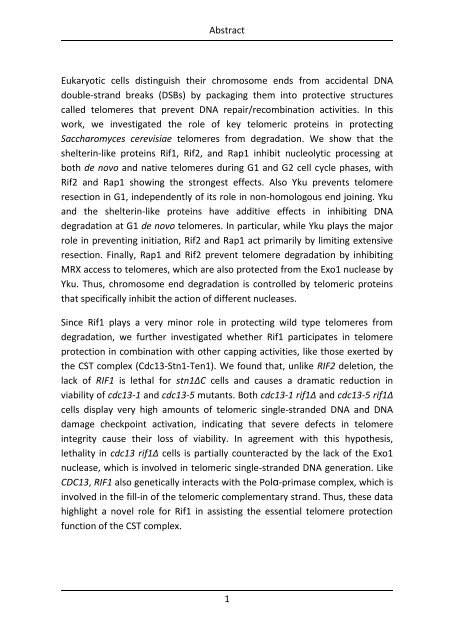View/Open - Università degli Studi di Milano-Bicocca
View/Open - Università degli Studi di Milano-Bicocca
View/Open - Università degli Studi di Milano-Bicocca
Create successful ePaper yourself
Turn your PDF publications into a flip-book with our unique Google optimized e-Paper software.
Abstract<br />
Eukaryotic cells <strong>di</strong>stinguish their chromosome ends from accidental DNA<br />
double-strand breaks (DSBs) by packaging them into protective structures<br />
called telomeres that prevent DNA repair/recombination activities. In this<br />
work, we investigated the role of key telomeric proteins in protecting<br />
Saccharomyces cerevisiae telomeres from degradation. We show that the<br />
shelterin-like proteins Rif1, Rif2, and Rap1 inhibit nucleolytic processing at<br />
both de novo and native telomeres during G1 and G2 cell cycle phases, with<br />
Rif2 and Rap1 showing the strongest effects. Also Yku prevents telomere<br />
resection in G1, independently of its role in non-homologous end joining. Yku<br />
and the shelterin-like proteins have ad<strong>di</strong>tive effects in inhibiting DNA<br />
degradation at G1 de novo telomeres. In particular, while Yku plays the major<br />
role in preventing initiation, Rif2 and Rap1 act primarily by limiting extensive<br />
resection. Finally, Rap1 and Rif2 prevent telomere degradation by inhibiting<br />
MRX access to telomeres, which are also protected from the Exo1 nuclease by<br />
Yku. Thus, chromosome end degradation is controlled by telomeric proteins<br />
that specifically inhibit the action of <strong>di</strong>fferent nucleases.<br />
Since Rif1 plays a very minor role in protecting wild type telomeres from<br />
degradation, we further investigated whether Rif1 participates in telomere<br />
protection in combination with other capping activities, like those exerted by<br />
the CST complex (Cdc13-Stn1-Ten1). We found that, unlike RIF2 deletion, the<br />
lack of RIF1 is lethal for stn1ΔC cells and causes a dramatic reduction in<br />
viability of cdc13-1 and cdc13-5 mutants. Both cdc13-1 rif1Δ and cdc13-5 rif1Δ<br />
cells <strong>di</strong>splay very high amounts of telomeric single-stranded DNA and DNA<br />
damage checkpoint activation, in<strong>di</strong>cating that severe defects in telomere<br />
integrity cause their loss of viability. In agreement with this hypothesis,<br />
lethality in cdc13 rif1Δ cells is partially counteracted by the lack of the Exo1<br />
nuclease, which is involved in telomeric single-stranded DNA generation. Like<br />
CDC13, RIF1 also genetically interacts with the Polα-primase complex, which is<br />
involved in the fill-in of the telomeric complementary strand. Thus, these data<br />
highlight a novel role for Rif1 in assisting the essential telomere protection<br />
function of the CST complex.<br />
1

















